Total Body Health
 Though the link between dental health and heart health is not completely clear, experts say it’s important to take care of both.
Claiming around 610,000 lives each year, heart disease is the No. 1 killer of both men and women in the U.S.1 Did you know that research has found a link between this deadly disease and the health of your gums?
Having gum disease increases the risk of a first heart attack by 28%, according to a 2016 study by the Karolinska University Hospital in Sweden.2
“Although the findings indicate a strong link between gum disease and heart disease, it’s still unclear whether one actually causes the other,” says the American Heart Association. The two conditions have some of the same risk factors, including smoking, poor nutrition and diabetes. Researchers believe that inflammation caused by periodontal disease may be responsible for the connection.3
Though the link between dental health and heart health is not completely clear, experts say it’s important to take care of both.
Claiming around 610,000 lives each year, heart disease is the No. 1 killer of both men and women in the U.S.1 Did you know that research has found a link between this deadly disease and the health of your gums?
Having gum disease increases the risk of a first heart attack by 28%, according to a 2016 study by the Karolinska University Hospital in Sweden.2
“Although the findings indicate a strong link between gum disease and heart disease, it’s still unclear whether one actually causes the other,” says the American Heart Association. The two conditions have some of the same risk factors, including smoking, poor nutrition and diabetes. Researchers believe that inflammation caused by periodontal disease may be responsible for the connection.3
Prevention is the best medicine
Regular healthy habits can lower your risk of both gum disease and heart disease. And, if you already have one or both of these conditions, these strategies can help reduce their impact:- Brush and floss regularly. To remove plaque-forming bacteria, brush for at least two minutes, twice a day, and don’t skip the floss.
- Choose a healthy diet, rich in essential nutrients (especially vitamins A and C). Reduce or eliminate sugar and starches.
- Avoid cigarettes and smokeless tobacco. These habits can destroy your gums and increase your chance of heart disease.
- 1CDC, NCHS. Underlying Cause of Death 1999-2013 on CDC WONDER Online Database, released 2015.
- 2Rydén L, Buhlin K, Ekstrand E, et al. Periodontitis increases the risk of a first myocardial infarction: A report from the PAROKRANK study. 2016.
- 3Jeffcoat et al. Impact of periodontal therapy on general health: evidence from insurance data for five systemic conditions. American Journal of Preventive Medicine. 2014;47(2):166-74.
- 4Gum Disease and Heart Disease. American Academy of Periodontology. Dec. 2016. http://www.perio.org/consumer/heart_disease
 istockphoto.com[/caption]
It’s the most wonderful time of the year… holiday parties, social occasions galore and, of course, mistletoe! Whether you’re holiday plans are filled with company parties or gatherings with old friends, the last thing you want to do is make an unpleasant impression with bad breathe, teeth stains, or spinach and artichoke dip stuck in your teeth.
How can you keep your teeth clean and your breath fresh during your holiday parties and get togethers without going to the bathroom every 5 minutes to check in the mirror or brush your teeth?
Here are 3 simple tips:
Drink to your health (and your breath). If you want to keep your smile bright, you should avoid drinking soda, black tea, coffee and red wine, which can stain your teeth. If you do drink these, the best way to avoid stains is to rinse your mouth with water immediately after consuming these beverages. Water helps keep bad breath under control because it washes away food particles and bacteria, the primary cause of bad breath. It also helps you avoid “dry mouth,” another cause of bad breath, by staying well-hydrated.
Take advantage of the healthy holiday snacks. While the spread at many holiday parties consists of lots of sweets and libations, there are some healthy holiday snacks that can keep your teeth clean and your breathe fresh. Parsley and peppermint are two staples during the holiday season and can be extremely helpful when you’re in desperate need. Parsley is a breath-saver because it contains chlorophyll, a known breath deodorizer. You can also splash a drop of peppermint oil into your sparkling water and you are good to go for hours. We wouldn’t recommend it in your beer though.
Keep quick cleaning basics close by. It might be impossible for you to brush your teeth each time you eat or between parties. Portable oral care basics like floss, Whisps, and mouthwash are great ways for a quick freshen up. They can also help remove the bacteria from hidden spaces that can’t be flushed out just by drinking water.
Whatever your plans are this holiday, we hope that your days (and your teeth) will be merry and white.
Happy Holidays from our entire staff!
istockphoto.com[/caption]
It’s the most wonderful time of the year… holiday parties, social occasions galore and, of course, mistletoe! Whether you’re holiday plans are filled with company parties or gatherings with old friends, the last thing you want to do is make an unpleasant impression with bad breathe, teeth stains, or spinach and artichoke dip stuck in your teeth.
How can you keep your teeth clean and your breath fresh during your holiday parties and get togethers without going to the bathroom every 5 minutes to check in the mirror or brush your teeth?
Here are 3 simple tips:
Drink to your health (and your breath). If you want to keep your smile bright, you should avoid drinking soda, black tea, coffee and red wine, which can stain your teeth. If you do drink these, the best way to avoid stains is to rinse your mouth with water immediately after consuming these beverages. Water helps keep bad breath under control because it washes away food particles and bacteria, the primary cause of bad breath. It also helps you avoid “dry mouth,” another cause of bad breath, by staying well-hydrated.
Take advantage of the healthy holiday snacks. While the spread at many holiday parties consists of lots of sweets and libations, there are some healthy holiday snacks that can keep your teeth clean and your breathe fresh. Parsley and peppermint are two staples during the holiday season and can be extremely helpful when you’re in desperate need. Parsley is a breath-saver because it contains chlorophyll, a known breath deodorizer. You can also splash a drop of peppermint oil into your sparkling water and you are good to go for hours. We wouldn’t recommend it in your beer though.
Keep quick cleaning basics close by. It might be impossible for you to brush your teeth each time you eat or between parties. Portable oral care basics like floss, Whisps, and mouthwash are great ways for a quick freshen up. They can also help remove the bacteria from hidden spaces that can’t be flushed out just by drinking water.
Whatever your plans are this holiday, we hope that your days (and your teeth) will be merry and white.
Happy Holidays from our entire staff!
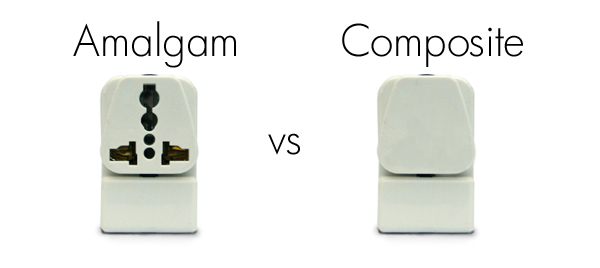 While the majority of dentists now use mercury-free composite fillings, some continue to use dental amalgam, also known as "silver fillings". Over the years, concerns have been raised about the use of amalgam because it contains mercury. Here are answers to some common patient questions about dental fillings.
While the majority of dentists now use mercury-free composite fillings, some continue to use dental amalgam, also known as "silver fillings". Over the years, concerns have been raised about the use of amalgam because it contains mercury. Here are answers to some common patient questions about dental fillings.
- The release of mercury vapor in the mouth lessens the strength, longevity, and resilience of the filling.
- Corrosion of the surface of the filling due to the persistently wet environment. This process is similar to rusting iron.
- Attrition of the surface and edges of the filling from eating, clinching, and grinding cause the edges to be tattered and irregular, causing food traps.
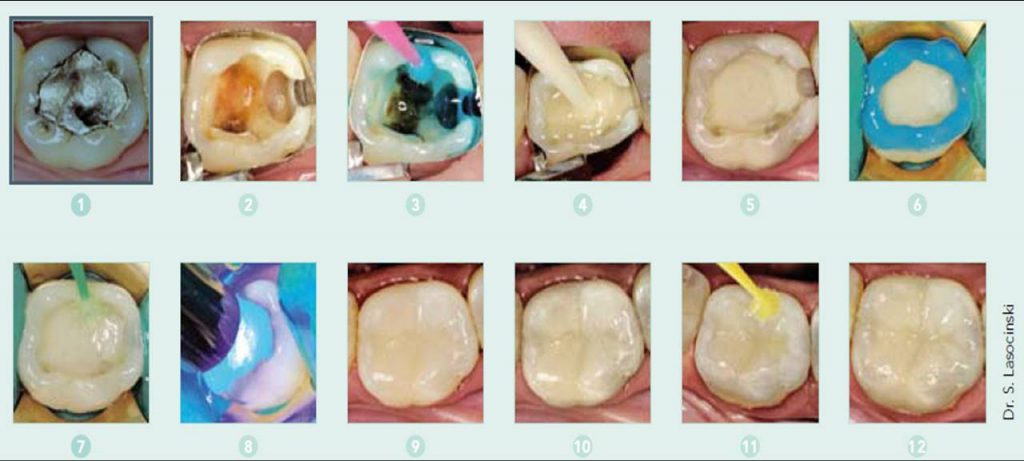 What you can't see: decay often occurs underneath amalgam fillings, and it doesn't always present on x-rays. By removing "silver fillings" and replacing with white composite resin, your dentist will accurately assess any future damage and treat with tiny fillings versus more indepth restorations like crowns, root canals, and/or dental implants.[/caption]
What you can't see: decay often occurs underneath amalgam fillings, and it doesn't always present on x-rays. By removing "silver fillings" and replacing with white composite resin, your dentist will accurately assess any future damage and treat with tiny fillings versus more indepth restorations like crowns, root canals, and/or dental implants.[/caption]
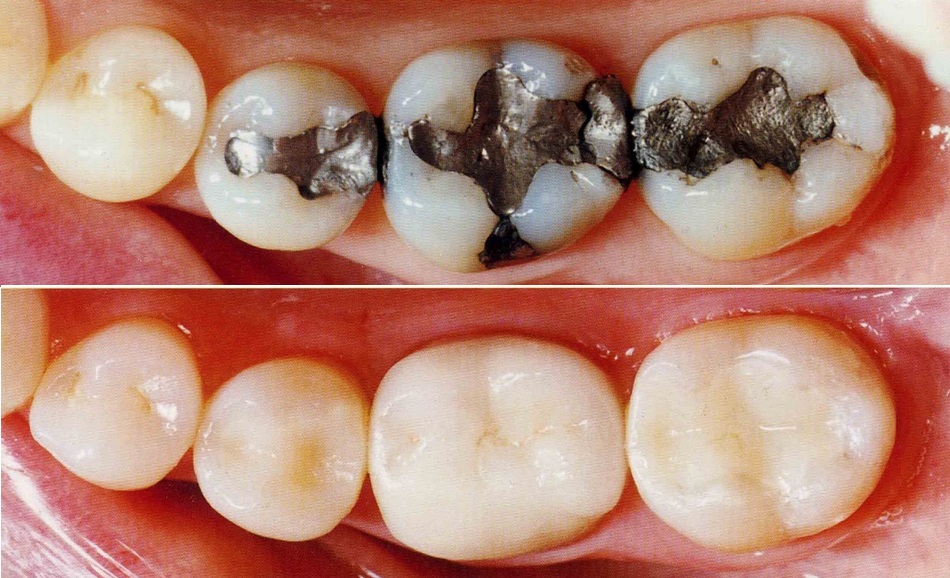 Amalgam v/s Composite Fillngs[/caption]
Amalgam v/s Composite Fillngs[/caption]
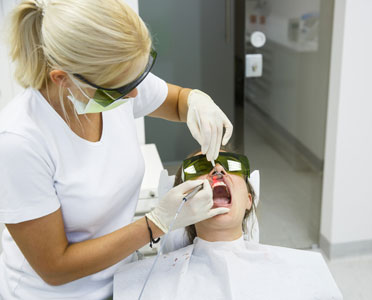 In 2004, Time Magazine ran a cover story entitled "The Secret Killer.". It addressed the "surprising link between inflammation and heart attacks, cancer, alzheimers, and other diseases, and what we can do to fight it." The article reported that simply "flossing your teeth combats gum disease, a source of chronic inflammation." READ ARTICLE
The media had finally awakened to a problem that we have already identified and begun to aggressively treat. In addition to using floss and other personal oral hygiene products, we now use lasers to kill the bacteria associated with gum disease, inflammation and infection. Laser Bacterial Reduction (LBR) enables us to destroy the bacteria that cause inflammation and periodontal disease. In other words, just by circling the teeth with the laser, we can drastically reduce the harmful bacteria that can compromise our dental and overall health. The application of the laser can take bacterial counts around an inflamed periodontal pocket from billions down to hundreds within seconds.
In 2004, Time Magazine ran a cover story entitled "The Secret Killer.". It addressed the "surprising link between inflammation and heart attacks, cancer, alzheimers, and other diseases, and what we can do to fight it." The article reported that simply "flossing your teeth combats gum disease, a source of chronic inflammation." READ ARTICLE
The media had finally awakened to a problem that we have already identified and begun to aggressively treat. In addition to using floss and other personal oral hygiene products, we now use lasers to kill the bacteria associated with gum disease, inflammation and infection. Laser Bacterial Reduction (LBR) enables us to destroy the bacteria that cause inflammation and periodontal disease. In other words, just by circling the teeth with the laser, we can drastically reduce the harmful bacteria that can compromise our dental and overall health. The application of the laser can take bacterial counts around an inflamed periodontal pocket from billions down to hundreds within seconds.
Downtown Dental uses lasers to attack periodontal inflammation at the microscopic level of infection. The power of its focused light destroys otherwise inaccessible bacterial colonies while simultaneously creating an ideal environment for healing. Today, our practice offers our patients the hope of a better tomorrow by providing oral health care in ways that were science fiction only a few years ago.
We are not only cleaning teeth and creating beautiful smiles: with our progressive dental laser therapy, we are enhancing your lifestyle and hopefully prolonging your life.
Hear one patient's story of Laser Bacteria Reduction (LBR) to treat gum infection. image via sciencetimes.com[/caption]
We're never going to tell anyone they shouldn't enjoy a drink (especially around the holidays), but there are some dental dangers to over-imbibing. But are moderate drinkers at risk for serious tooth and mouth disease? There isn’t much conclusive medical evidence, but dentists say that they see the effects of moderate drinking regularly.
The main threat to your teeth and gums comes from the sugar content in alcohol (including beer) which, when broken down in your mouth, creates an acidic breeding ground for bacteria and plaque.
There is also a strong clinical link between the excessive consumption of alcohol and head and neck cancers. In fact, while it can increase the risk of getting these diseases if used together with tobacco, alcohol can pose a risk in its own right.
People most often associate the health risks of excessive alcohol drinking with damage to the liver or stomach lining. But during Alcohol Awareness Month, Delta Dental warns that alcohol abuse can also prove harmful to oral health.
It is estimated that each year in the United States there will be more than 30,000 new cases of oral cancer diagnosed and about one person every hour will die from this disease.
1. Heavy alcohol consumption is a risk factor for oral cancer.* According to the American Cancer Society, about 70 percent of oral cancer patients consume alcohol frequently.
2. Tobacco smoking (i.e., cigarette, pipe or cigar smoking), particularly when combined with heavy alcohol consumption, has been identified as the primary risk factor for approximately 75 percent of oral cancers in the U.S.
3. Using tobacco with alcohol poses a much greater risk than ingesting either substance alone. According to the National Institute on Alcohol Abuse and Alcoholism, there are approximately 17.6 million adults who are alcoholics or have alcohol problems.3
People with alcohol problems also tend to neglect other healthy habits like eating properly or taking care of daily hygiene. A small 2003 study conducted at an alcohol rehabilitation center found that residents had a higher incidence of periodontal (gum) disease and cavities.
image via sciencetimes.com[/caption]
We're never going to tell anyone they shouldn't enjoy a drink (especially around the holidays), but there are some dental dangers to over-imbibing. But are moderate drinkers at risk for serious tooth and mouth disease? There isn’t much conclusive medical evidence, but dentists say that they see the effects of moderate drinking regularly.
The main threat to your teeth and gums comes from the sugar content in alcohol (including beer) which, when broken down in your mouth, creates an acidic breeding ground for bacteria and plaque.
There is also a strong clinical link between the excessive consumption of alcohol and head and neck cancers. In fact, while it can increase the risk of getting these diseases if used together with tobacco, alcohol can pose a risk in its own right.
People most often associate the health risks of excessive alcohol drinking with damage to the liver or stomach lining. But during Alcohol Awareness Month, Delta Dental warns that alcohol abuse can also prove harmful to oral health.
It is estimated that each year in the United States there will be more than 30,000 new cases of oral cancer diagnosed and about one person every hour will die from this disease.
1. Heavy alcohol consumption is a risk factor for oral cancer.* According to the American Cancer Society, about 70 percent of oral cancer patients consume alcohol frequently.
2. Tobacco smoking (i.e., cigarette, pipe or cigar smoking), particularly when combined with heavy alcohol consumption, has been identified as the primary risk factor for approximately 75 percent of oral cancers in the U.S.
3. Using tobacco with alcohol poses a much greater risk than ingesting either substance alone. According to the National Institute on Alcohol Abuse and Alcoholism, there are approximately 17.6 million adults who are alcoholics or have alcohol problems.3
People with alcohol problems also tend to neglect other healthy habits like eating properly or taking care of daily hygiene. A small 2003 study conducted at an alcohol rehabilitation center found that residents had a higher incidence of periodontal (gum) disease and cavities.
Limiting the Damage
- Most importantly, after a night out, you should brush and floss your teeth before going to bed. If you often forget to do this, leave your tooth brush on your pillow before you go out to remind you to spend a couple of minutes brushing.
- While you’re drinking try to swish a mouthful of water around every so often to increase the saliva flow and rinse away sugars and acid in your mouth
- On your way home, chew sugar-free gum to stimulate saliva flow and clear the mouth of harmful sugars and acid.
 image via deathsplaining.wordpress.com[/caption]
How Does Coffee Stain Teeth?
Although the enamel of your teeth is the hardest substance in the human body, it is not flat and smooth. On the contrary, your tooth enamel contains microscopic pits and ridges that can hold particles of food and drink.
Pigments from dark-colored drinks such as coffee, tea, and soda can become embedded in those cracks and ridges and, if the proper steps are not taken, can cause permanent, yellowing stains on your teeth.
Does Coffee Stain Teeth Less If You Add Cream?
While it may seem that lighter-colored coffee would stain less, the same pigments and acids are present in coffee with cream as black coffee; thus, adding any sort of whitener to your coffee will not prevent your teeth from becoming stained, unless you put significantly less coffee in your cup to make room for the cream.
How Can One Prevent "Coffee Smile"?
Giving up coffee, tea, or other tooth-staining beverages is the best way to prevent the staining caused by those drinks, but for most people, this is not an acceptable solution.
Rather than abstaining, try to consume your coffee at specific break times, rather than sipping constantly throughout the day. After finishing your coffee, you can then rinse your mouth out with water or brush your teeth to remove the potentially yellowing pigments from your teeth.
Using a whitening toothpaste and brushing regularly is a good way to maintain whiter teeth at home. In addition, visiting your dentist's office for regular cleanings can remove many of the surface stains on your teeth, giving you a whiter smile, no matter how many cups of coffee you need to make it through the day.
resource: Colgate
image via deathsplaining.wordpress.com[/caption]
How Does Coffee Stain Teeth?
Although the enamel of your teeth is the hardest substance in the human body, it is not flat and smooth. On the contrary, your tooth enamel contains microscopic pits and ridges that can hold particles of food and drink.
Pigments from dark-colored drinks such as coffee, tea, and soda can become embedded in those cracks and ridges and, if the proper steps are not taken, can cause permanent, yellowing stains on your teeth.
Does Coffee Stain Teeth Less If You Add Cream?
While it may seem that lighter-colored coffee would stain less, the same pigments and acids are present in coffee with cream as black coffee; thus, adding any sort of whitener to your coffee will not prevent your teeth from becoming stained, unless you put significantly less coffee in your cup to make room for the cream.
How Can One Prevent "Coffee Smile"?
Giving up coffee, tea, or other tooth-staining beverages is the best way to prevent the staining caused by those drinks, but for most people, this is not an acceptable solution.
Rather than abstaining, try to consume your coffee at specific break times, rather than sipping constantly throughout the day. After finishing your coffee, you can then rinse your mouth out with water or brush your teeth to remove the potentially yellowing pigments from your teeth.
Using a whitening toothpaste and brushing regularly is a good way to maintain whiter teeth at home. In addition, visiting your dentist's office for regular cleanings can remove many of the surface stains on your teeth, giving you a whiter smile, no matter how many cups of coffee you need to make it through the day.
resource: Colgate
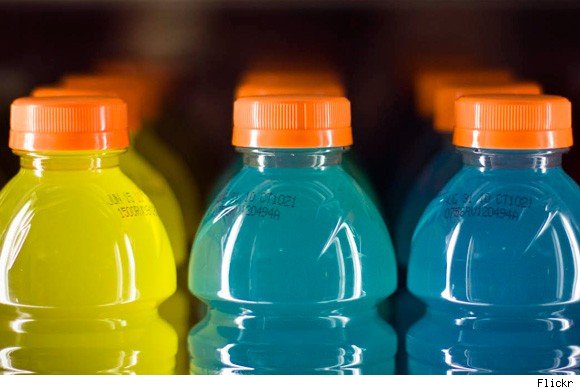 Energy and sports drinks can damage tooth enamel, boosting the risk of cavities, according to an American Journal of Dentistry study.
The big misconception is that energy drinks and sports drinks are healthier than soda for oral health, but studies disproves that, because they erode or thin out the enamel of the teeth, leaving them more susceptible to decay and sensitivity.
Energy and sports drinks can damage tooth enamel, boosting the risk of cavities, according to an American Journal of Dentistry study.
The big misconception is that energy drinks and sports drinks are healthier than soda for oral health, but studies disproves that, because they erode or thin out the enamel of the teeth, leaving them more susceptible to decay and sensitivity.
The drinks are especially popular among teens and young adults. Up to half of U.S. teens and young adults drink energy drinks, and more than half have at least one sports drink a day, according to the researchers.
Researcher Poonam Jain, BDS, MPH, associate professor and director of community dentistry at the Southern Illinois University School of Dental Medicine and her team tested 13 sports drinks and nine energy drinks for acidity. They tested six drinks for their effects on tooth enamel and found both types caused damage. Energy drinks, however, were twice as bad. Remember:damaged tooth enamel cannot be fixed.Jain's team immersed enamel samples from extracted human teeth into three sports drinks and three energy drinks.
They tested the acidity levels of all 22 drinks. They found the levels of acidity in the drinks vary between brands and between flavors of the same brands.
Sports drinks, energy drinks, and teeth: study details
Up to half of U.S. teens and young adults drink energy drinks, and more than half have at least one sports drink a day, according to the researchers. Other study results included:Gatorade Blue had the highest acidity among sports drinks. Next was Hydr8.
Among the energy drinks with the highest acidity:
- Red Bull Sugar=free
- Monster Assault
- 5-hour Energy
- Von Dutch
- Rockstar
MDX had the lowest acidity of the energy drinks.
The sports drinks tested were:
- Gatorade Rain
- Powerade Option
- Propel Grape
The energy drinks tested were:
- Monster Assault
- Red Bull
- 5-hour Energy
The enamel samples were immersed in the drinks for 15 minutes. The researchers transferred the enamel to artificial saliva for two hours.
This cycle was repeated four times a day for five days. The beverages were replaced with fresh ones every day.
The cycle was meant to simulate real life, Jain says, as some teens and young adults drink the beverages every few hours.
Enamel loss was evident after five days of exposure, Jain says.
The average enamel lost with sports drinks was about 1.5%, while the average loss with energy drinks was more than 3%. Jain says she cannot pinpoint what percent of enamel loss would cause problems.
Advice for sports drink lovers
Even one drink a day is potentially harmful, Jain says.
"If the consumer is absolutely unable to give them up, the best advice is to minimize [their use] and rinse with water afterwards," she says.
"Dilute them," she says. Do not brush immediately after drinking them, she says, as this could spread around the acid. "The mouth takes about 30 minutes to bring the pH back to normal. Wait an hour after drinking the sports or energy drink, to be safe, then brush."
It is very important to read labels on any drink you choose to prevent the cavities and gum disease that these drinks can cause. Also, be aware that the cream and sugar you put in your coffee in the morning has the same effect as other high sugar drinks.
The best drink of choice for the health of your teeth and gums is plain water. We're realistic though, and understand this can be difficult for anyone to regularly practice. If you’re going to have a soda or sweetened drink, be careful to drink them all in one sitting rather than sipping for a long time, and try to have a drink of water when you’re finished.
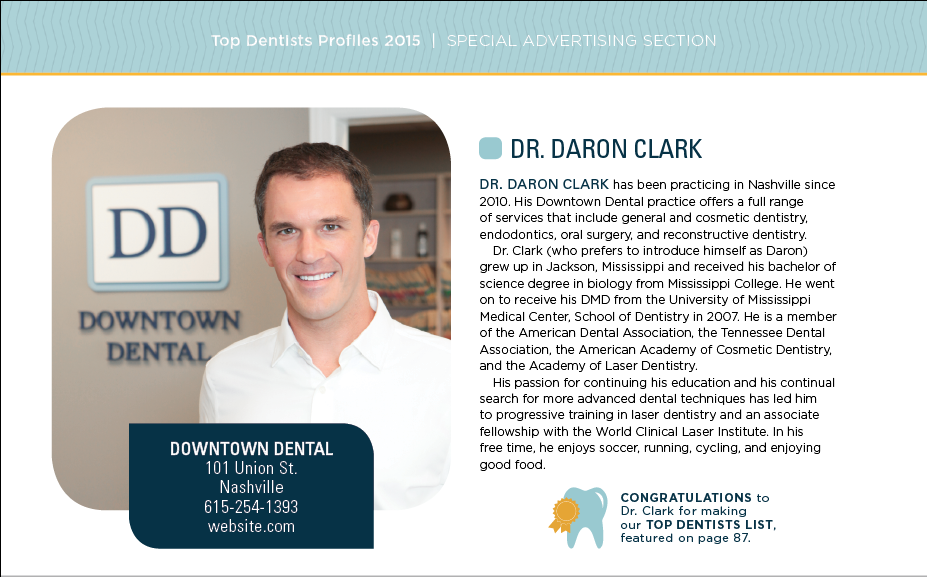 You may see a familiar face in the September 2015 issue of Nashville Lifestyles Magazine! We're thrilled to have Dr. Clark listed among the TOP DENTISTS of Nashville. This ranking system is cool because it's ranking done by fellow colleagues: consider it a way for the dental community to comment on the top doctors in their industry. It's like a clinical high five! Click on the photo to expand or pick up your own copy at the news stand!
You may see a familiar face in the September 2015 issue of Nashville Lifestyles Magazine! We're thrilled to have Dr. Clark listed among the TOP DENTISTS of Nashville. This ranking system is cool because it's ranking done by fellow colleagues: consider it a way for the dental community to comment on the top doctors in their industry. It's like a clinical high five! Click on the photo to expand or pick up your own copy at the news stand!


